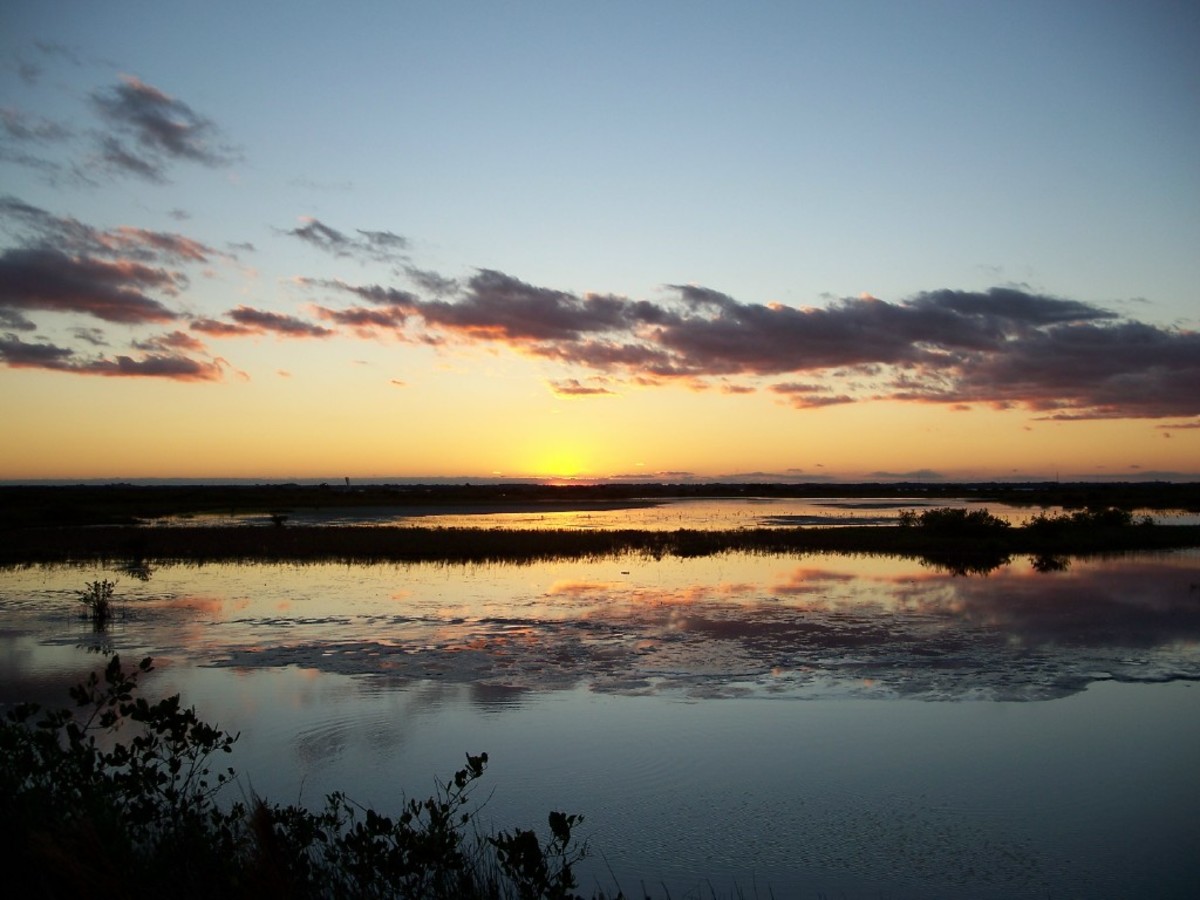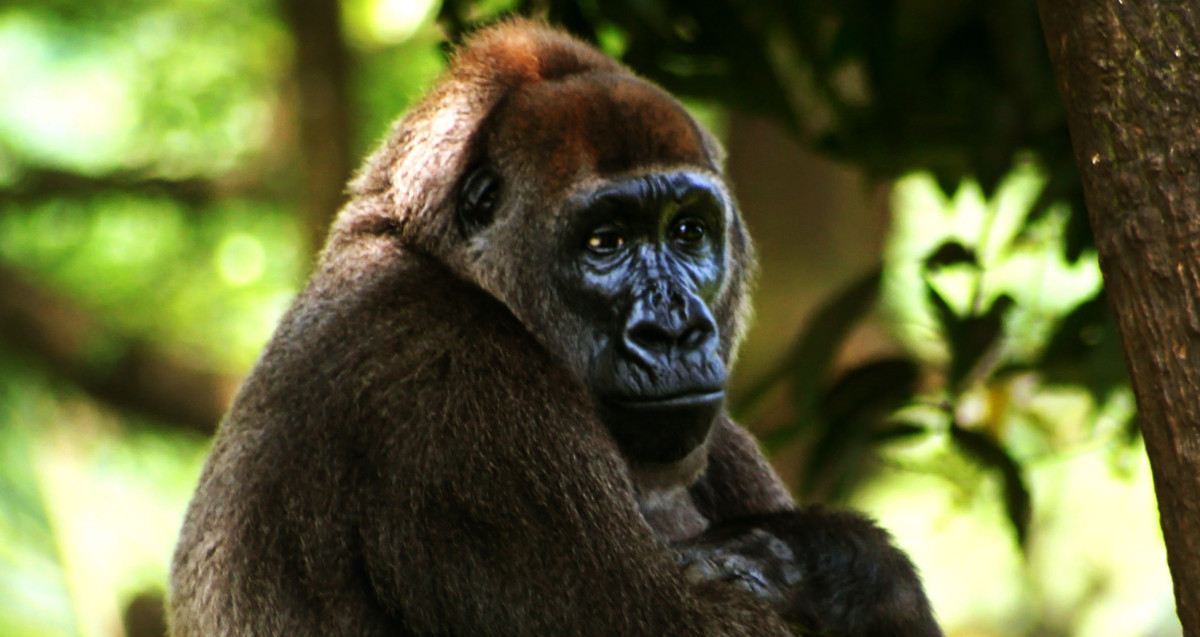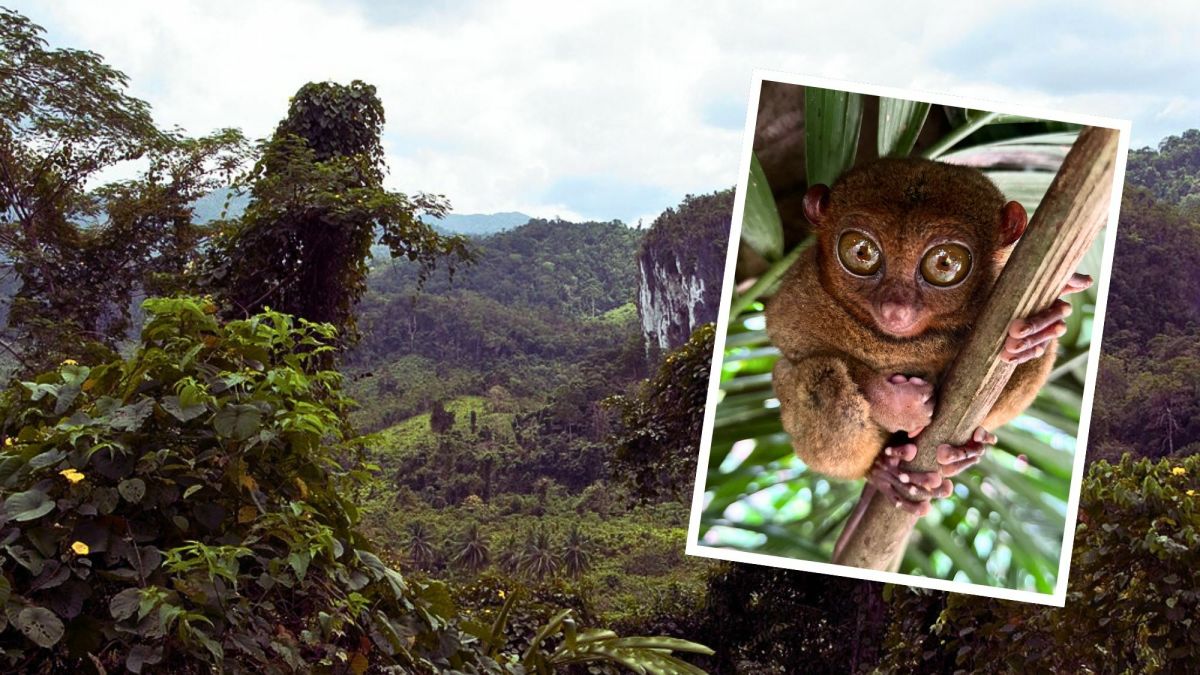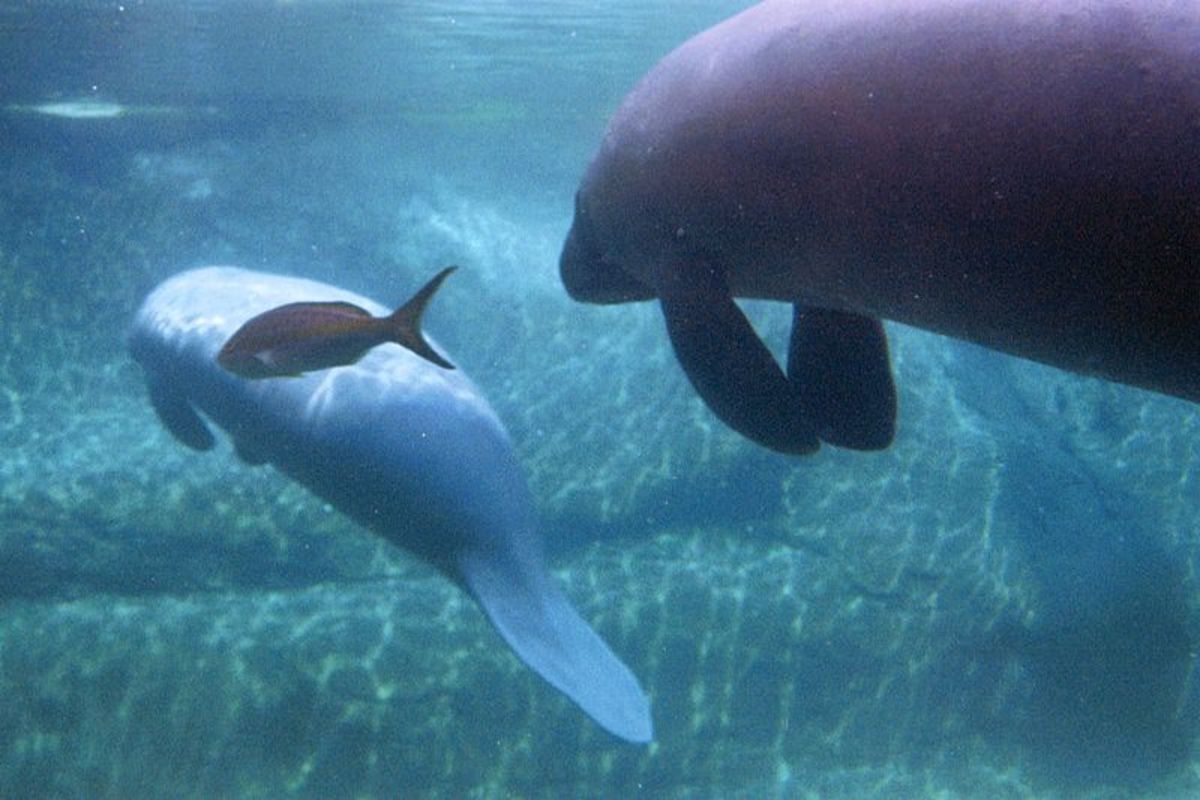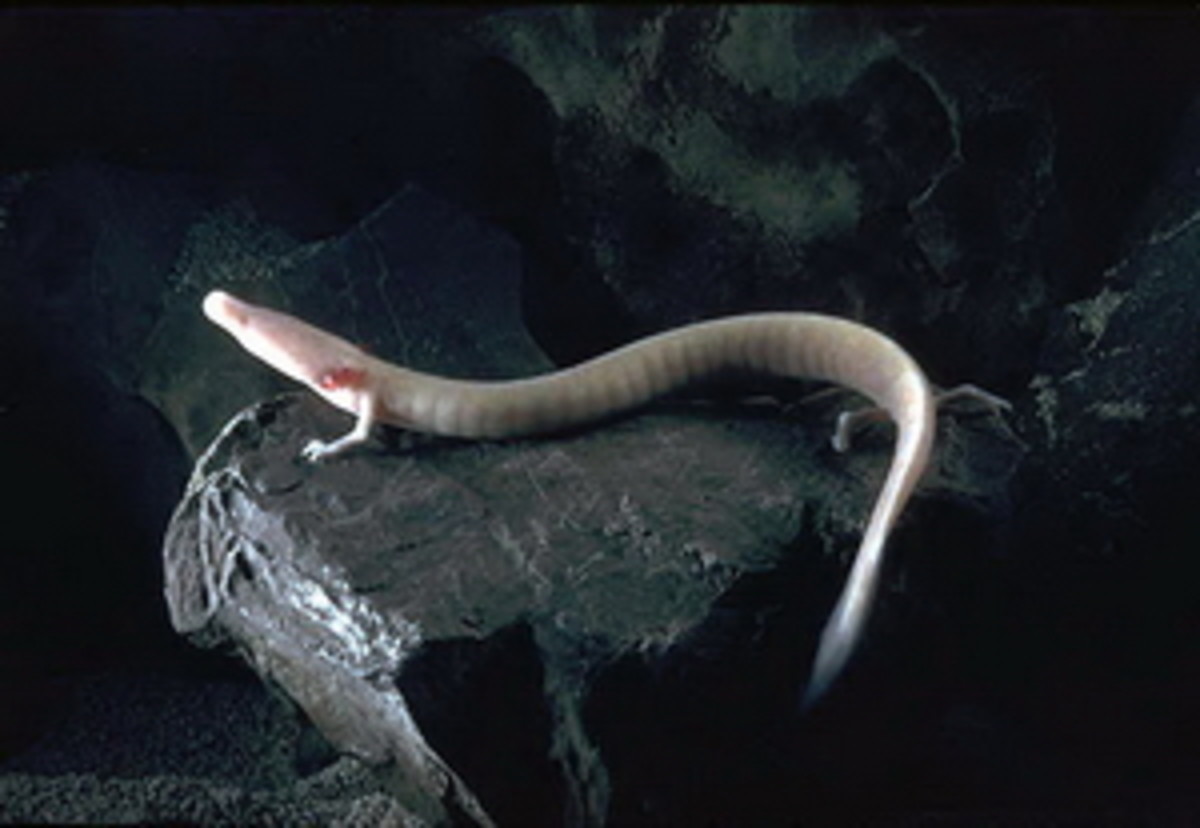A Cry for Help: Plight of the Sea Cow
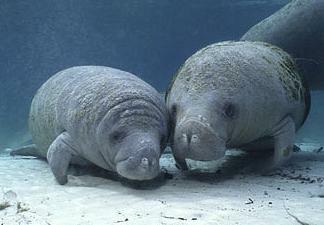

Record Number of Manatee Deaths Reported for 2013
According to the Florida Fish and Wildlife Research Institute in St. Petersburg, Florida, 803 manatee deaths have been recorded for 2013. This makes approximately 16 % of the state's estimated population of 5,000 manatees.
In 2010, the record for manatee deaths was 766.
Source: Tampabay.com
Among Florida’s most popular exotic wildlife is the Florida manatee, or sea cow, (Trichechus manatus latirostris), a subspecies of the West Indian manatee (Trichechus manatus). A large herbivorous, aquatic mammal that can be found in the shallow coastal waters, rivers, springs of Florida, and adjoining states. These gentle creatures are endangered throughout their range, and their high annual mortality is primarily due to human activity, low reproductive rate and loss of habitat (Van Meter, p. 3). Their popularity, which largely lies in their endangered status, comes from a statewide effort to preserve the specie and much controversy. The future of the manatee lies in public awareness, isolating the problems that placed them in the endangered list, and finding better solutions.
It first began as early as 8500 BC, when manatees were hunted for meat, bone, hides and fat by the Paleo-Indians, and later by Native Americans, and Europeans; this hunting continued well into the 1970’s. Today, hunting, poaching, and vandalism are illegal in the U.S; the number of deaths each year continues to decline due to public awareness and law enforcement efforts. (Van Meter, p. 12-13, 24). This was one of many factors that contributed to their considerable decline in numbers, triggering the attention of the federal government. When the manatee population was thought by the EPA to number less than a thousand, in 1972 the federal government included the specie in the Marine Mammal Protection Act and a year later, in the federal endangered species list (Verdon, par. 7). During this time, the U.S. Fish and Wildlife Service and the University of Miami conducted examinations on the manatee carcasses to determine the cause of death, functional anatomy, and interpret important life history attributes. Since 1974, over 4,000 dead manatees have been collected and examined.
Today, the Florida Fish and Wildlife Conservation Commission collect and examine over 250 manatee carcasses annually; information gathered through the Manatee Salvage Program, has identified that over 30% of all 4,000 manatee deaths have been attributed to human activities; specifically, collision with watercrafts, which was the largest single known cause of their mortality. According to the Florida Marine Research Institute, approximately 45% of all manatee deaths caused by boats are due solely to propeller cuts, and 50% are due to blunt trauma caused by boat hulls running into them, while the remaining 5% are due to a combination of both (Van Meter, p. 21-22). An identification catalog of more that 1,200 individual Florida Manatees have been compiled by the Sirenia Project and other groups, by using identifying marks such as the grotesque scar patterns left on their backs by fast-churning boat propellers (Stewart, par. 7). Soon thereafter, the Florida Fish and Wildlife Conservation Commission (FWCC) became responsible for working with 13 Florida counties where more than 80% of manatee deaths were reported; as a result, a series of speed zones went up across Florida in the 1990’s (Verdon, par. 8).
Establishing the main cause for their high mortality and the efforts of assigned state agencies, did little to resolve the problem of watercraft related deaths. In January 2000, Save the Manatee Club and 13 other co-defendants sued both the U.S. Wildlife service and the FWCC in two separate lawsuits for failure to enforce the Marine Mammal Protection and Endangered Species act, citing a growing trend of boat-related manatee deaths, and said the agencies weren’t doing enough to protect manatees (Verdon, par. 9). This sparked outrage and heated arguments over speed zone regulations resulting in countersuits. Boating rights activists, and sport fishing organizations such as the CCAF petitioned for a review of the manatee’s endangered species designation, using numbers from a survey where 50 planes literary counted heads by flying over known manatee habitats, they pointed to the species’ healthy population growth; the FWCC agreed to do such a review (Verdon, par. 19-21). Save the Manatee Club’s Vallee counters that the aerial survey, used in their argument for delisting, was not intended to be used to show manatee population trends. “If the count went down by 1,000 next year, would they cry that it’s down by 40 percent?” Vallee asks. “Absolutely not.” (qtd. in Verdon, par. 23).
While boaters’ groups argue that slow speed zones will not cure the problem, the Brevard County plaintiff’s brought Edmund Gerstein, Director of Marine Mammal Research and Aquatic Science at Florida Atlantic University, to prove it. After spending years studying the manatee’s hearing abilities, Gerstein came to the conclusion that they have trouble with low-frequency sounds. “Manatees can hear boats,” he says, “but not very well. An idling boat is nearly acoustically invisible to them.” Also adding that the manatee can hear a fast boat long before it can hear a boat idling nearby (qtd. in Verdon, par. 30). On the other hand, past research show that despite the absence of external ear lobes and the small size of the auditory openings, manatees hear very well. Some studies suggest that manatees may even be able to hear sounds that are too low for humans to detect. Manatee cows respond to the squeals of their calves from almost 200 feet away, and adult manatees have been reported to respond to sounds 160 feet away (qtd. in Van Meter, p. 18).
Furthermore, Gerstein claims that “A manatee is not all that slow…if frightened or excited, it can explode, moving 21 feet per second” (Stewart, par. 19), other research shows that clocked at speeds of up to 15 miles per hour for short bursts, manatees generally cruise at speeds of 2-6 miles per hour (Van Meter, pg. 16). This is an area where more research is needed, escaping fast boats should not be the only problem to be considered here, but the fact that there may not be enough clearance for the manatee to get out of the way, even when a boat is moving slowly should also be taken into account (Van Meter, p.25). In spite of laws and regulations, and much controversy, Florida boat registrations soared, and manatee deaths hit a record high of 95 in 2002 (McManus, p.2)
The beautiful tropical weather, exotic wildlife, water sports, and many tourist attractions, has made Florida a permanent home for many, making the population growth and the waterfront development another controversial issue. The loss of habitat has become one of the most serious threats to the manatee, as it is for all of Florida’s wildlife. Many freshwater and marine grass beds have been reduced or eliminated by water pollution, herbicides, dredge and fill projects and surface runoff. Formerly productive areas have been extensively modified by human activity and many natural warm-water areas have been affected by loss or reduction of artesian flows (Van Meter, p. 24).
One problem it has created, according to Standing Watch’s Kalvin, is that the state has imposed other restrictions on marinas, and says that marinas have been: “systematically eliminated through development pressure that makes getting a permit to upgrade a facility literally impossible in the state” (qtd. in Verdon, par. 33). Save the Manatee’s Vallee says that as Florida is developing, much of their habitat is going to be lost, and she adds: “With nearly a million boats and only 3,200 manatees, the threats are increasing” (Verdon, par. 34).
Loss of habitat and restrictions on marinas, are not the only concern; another important factor in the manatee’s mortality rate due to human causes are power plants. Power plants alter the manatee’s natural movement and shift in winter distribution when temperatures fall below 59o F. These industrial sites with warm-water discharges attract large numbers of manatees seeking warm waters (Van Meter, p. 21), were they congregate at about a dozen warm-water sources during the winter.
The demands for cleaner, more efficient energy are prompting for these coal-fired plants to be closed, threatening the already endangered species (Bailey, par. 1). Due to the manatees’ congregation around these warm-water sources during cold weather, closing the power plants has resulted disastrous. Exposure to cold weather is one of the leading causes of death for Florida manatees. Manatees exposed to long-term moderate cold do not eat properly. These animals lose weight, become malnourished, and can die from hypothermia, or other cold-related illnesses. Larger manatees are usually older, they have much more experience using the warm water refuges during the winter; smaller younger manatees may not realize when they need to move to warm water and may not know where these sites are located; therefore, getting to warm water is an important determinant as to whether or not they survive the winter (Van Meter, p. 26-27).
In addition to man-made warm waters, ecotourism has become another problem for the manatee. Because they’re so peaceful, because they’re almost as “cute” as dolphins, and because they’re unique to Florida waters, swimming with the manatees has become a big eco-tourism business (Motavalli, par. 3). The sight of one of these animals in its natural habitat is a memorable experience, for both residents and visitors enjoying Florida’s waterways.
Although the inherent value of manatees is difficult to determine, manatees bring millions of dollars to Florida’s economy through the eco-tourism industry (Van Meter p.13). Marine Sanctuaries have been set aside on the coasts to serve as manatee refuges, and federal guidelines allow divers and snorkelers to touch a manatee as long as the animal comes to them first and the swimmers touch it only on one open hand—and intimacy prohibited with other endangered species. According to Patti Thompson, a biologist with Save the Manatee Club, manatees that solicit handouts or that seem to pose for photos are behaving unnaturally, and points out that non-habituated manatees are spooked by people standing on the beach (Stewart, par. 24).
Since the manatee has no natural predators, even sharks and alligators leave them alone, (Motavalli, par. 8), Thompson argues, gauntlets of underwater tourists in some areas, could interfere with natural behavior such as reproduction and nursing, and adds: “Manatees’ lack of predators has allowed them to evolve without the kinds of defenses that other animals have. They’re not being sweet and gentle. They’re being manatees” (Stewart, par. 24-25).
Although swimming with manatees is not an immediate threat to the species, other factors in their decline are flood gates and canal structures. They can kill manatees by trapping them underwater until they drown or by crushing them. One acutely problematic area is in Dade County, where automatic flood-control structures kill more manatees than boat traffic (Van Meter, p. 23).
Entanglement in monofilament fishing line, crab pot float lines, as well as ingestion of monofilament line and fishing tackle, are also problems manatees face. Lines may wrap so tightly around their flippers that severe infections, amputation, or death may result. Several manatees are rescued each year due to entanglements. The number of entanglement-related rescues appears to be increasing each year. This may be due, in part, to a 1995 ban on the use of nets greater than 500 square feet of mesh area in Florida waters. This appears to have resulted in an increase in the number of crab pots being fished each year (Van Meter, p.24).
Contamination of the waters is not limited to fishing lines; but, pesticides, herbicides, and industrial chemicals are found in manatee habitat as well, where they contaminate the water and vegetation ingested by manatees. These substances can accumulate in manatee tissue. Some studies have revealed that some manatees have high concentrations of copper in their tissues, probably as a result of feeding on vegetation treated with copper-based herbicides. Copper-based herbicides were once widely used in areas where manatees gather. Herbicide spraying is now restricted by state rule Chapter 62C-20, FAC, which prohibits the application of herbicides in areas where manatees are sighted and limits the application of copper-based herbicides to waters not associated with manatee gathering areas. The effects of these contaminants are poorly understood. Researchers are concerned that they may act as stressors that may impair the manatees’ ability to ward off naturally occurring illnesses (Van Meter, p.25-26).
Pollutants in the water such as red tide, a natural factor, have become a subtler enemy and play a major role in their decline in numbers. In the spring of 1995, nearly 158 manatees were killed due to red tide-- an explosive bloom of toxic algae. Nearly 800 Manatees swam up the Caloosahatchee River in West Central Florida to hang out in the warm water around a power plant; as the weather warmed, the manatees began to swim downriver; and as they were coming out, red tide was coming in (Abrams, par. 1). Inhalation of brevetoxin was suspected in their deaths. Similarly, during the spring of 1982, at least 37 manatees died in Lee County in the lower Caloosahatchee River and San Carlos Bay in association with an outbreak of red-tide (Van Meter, p. 27).
Once the problems have been isolated, understanding the specie is crucial to arrive at the best possible solutions. Manatees move slowly, inhabit shallow coastal regions, and must come to the surface to breathe. These factors may make it difficult for manatees to avoid fast moving boats or boats traveling in shallow water (Van Meter, p. 22). The manatee avoids flats and shallow waters, they prefer water depths of at least three to seven feet, and are rarely seen in areas over 20 feet deep (Van Meter, p. 7-8). Manatees at rest have relatively low heart rates compared to those of terrestrial mammals. A large, resting manatee can stay submerged for 20 minutes (Van Meter, p 10). Smaller and active manatees cannot stay under for that long and need to breathe every two to three minutes (Van Meter, p. 13-14).
Manatees spend about six to eight hours a day feeding and in that time may consume about four to nine percent of their body weight in wet vegetation, and can crawl partway onto a bank to reach shoreline vegetation (Van Meter, p. 17). Boaters can help reduce the risk of injuring or killing a manatee by staying within marked channels, obeying speed zones, wearing polarized glasses, and traveling cautiously in shallow water. Propeller guards may help reduce the number of injuries and deaths from propellers, but would not resolve the problems related to boat hulls (Van Meter, p.22).
In addition to propeller guards, and obeying slow speed zone regulations, further research and testing to determine its effectiveness and possible harmful effects to the specie and other wildlife, is a low-frequency sound-emitting device developed by Edmund Gerstein that will warn manatees of approaching boats, and if possible give them time to dive. He believes this $100 device could be an inexpensive solution (Verdon, par. 31).
One suggested solution to the power plant problem is that solar-powered warm-water refuges be built to harbor manatees during the winter months. Currently, scientists and power plant executives, along with manatee conservation advocates are looking for solutions (Bailey, par. 6).
To resolve the problem with flood gates, flood control structures and navigation locks are being equipped with manatee protection devices that detect a manatee’s presence. While this technology is promising, additional testing and fine-tuning is needed to make structures completely manatee-safe (Van Meter, p. 23).
The Florida DEP is considering steps to protect them from future red tides. “The algae don’t survive well in low-salinity water,” says Scott Wright, a marine mammalogist at the Florida Department of Environmental Protection. He says that one way to help is to make the water less salty, and claims you can do that by pushing freshwater into an area with a lot of red tide (Abrams, par.1).
The motorboat industry’s request to downgrade their state status from endangered to threatened was conceded; however, after much debate and rulings, the manatee continues to be listed as endangered in Florida. The downgrading of the species to the “threatened status” retains its federal protection, but public support can weaken when that happens (McManus, par. 2). Meanwhile, speed zones should be enforced, and with implemented boat licensing regulations, the species can have some guarantee of survival. Furthermore, the change of “petting” laws to “no touch” laws will eliminate altering their behavior; stricter laws and penalties, along with public education and awareness with collaborative efforts nationwide can secure their future and prevent the manatee from becoming endangered.
Works Cited
Abrams, Michael M. “Bad Tidings for Manatees.” Discover 18 January 1997: 71. Wilson
Select Plus. OCLC. 1 July 2003 <http://newfirstsearch.oclc.org>
Bailey, Ronald. “Hot Water.” Reason 34 March 2003: 11. Academic Search Premier. EBSCO. 1 July 2003 <http://web8.epnet.com>
McManus, Reed. “Florida Manatee Mandate.” Sierra 88 May/June 2003: 52. Academic Search Premier. EBSCO. 1 July 2003 <http://web20.epnet.com>
Motavalli, Jim. “Manatee Mania: Is Florida Loving its Endangered Marine Mammals to Death?” E: the Environmental Magazine 8 March/April 1997: 46-47. Wilson Select Plus. OCLC. 1 July 2003 <http://newfirstsearch.oclc.org>
Stewart, Doug. “Making Sense of Manatees.” National Wildlife 37 April/May 1999: 40-47. Wilson Select Plus. OCLC. 1 July 2003 <http://newfirstsearch.oclc.org>
Van Meter, Victoria Brook. “The West Indian Manatee in Florida.” FPL Booklet (1989- rev. 2001): 1-41.
11 July 2003 <http://www.floridaconservation.org/psm/manatee/manatee booklet.pdf>
Verdon, Michael. “Can Boaters and Manatees Coexist?” Boating World 23 March 2002: 88-
94. Wilson Select Plus. OCLC. 1 July 2003 <http://newfirstsearch.oclc.org>

©Faithful Daughter


